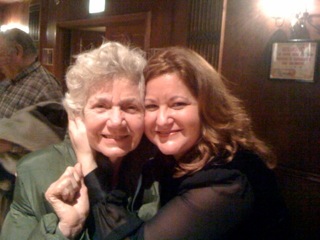Reviving Virginia Woolf
June 13, 2013 • 12 Comments • Posted in blindness, Blogroll, UncategorizedChicago’s Steppenwolf Theatre Company’s revival of Edward Albee’s “Who’s Afraid of Virginia Woolf?” won three Tony Awards last Sunday, including
Best Actor for ensemble member Tracy Letts. This good news gives me an opportunity to excerpt a post I published here two years ago after seeing the play here in Chicago. Better put, when I felt and heard the play: Steppenwolf provided special programming for the blind, and that was the first time I ever participated in a special touch tour. Here, from that 2011 post:
Touching Virginia Woolf
Two things convinced me to give this touch tour thing a try:
- We’d get to meet the actors and actresses before the play. I love meeting actors and actresses.
- Tickets for touch tour participants were half price.
Flo Finke didn’t raise no fool. I ordered two half-price tickets for the play, convinced my friend Brad to come along with me to the touch tour, and we settled into our seats two hours before the matinee started so we could hear the staff explain the set.
All of the action takes place in Martha and George’s living room, in a small college town somewhere in New England. The staff was familiar with the play, of course. They knew exactly which props were most vital to help us understand the action on stage. Doorbell chimes hanging by the entrance. A small photo of Martha’s father on the mantel. A toy gun with an umbrella that shoots out of the barrel. These explanations really helped. Example: Before the play, they pointed out an abstract 60s painting on the wall, towards the right, in George’s study. “It’s modern art,” they said. “Muddy blue swirls and brown tones. Not very interesting.” Later on in the play, when the actors are on the right side of the stage and someone asks about a painting, George says, “What it is, actually, is it’s a pictorial representation of the order of Martha’s mind.” Thanks to the presentation ahead of time, I understood how biting – and witty – George’s comment was. Which, in turn, helped me better understand the play.
The actors introduced themselves to us ahead of time, too.
“My name is Tracy Letts, I’m 45 years old. That’s the same age as George, who I’ll be playing today.” Each actor described their physical characteristics — “I’m…well, a big guy. I’m six foot three inches tall, about 210 pounds. Stocky, I guess” – and what they’d be wearing on stage. When Amy Morton, who plays George’s wife Martha, told us she was five foot ten, I could picture her pairing up well with Tracy Letts’ George.
The actors were happy to answer any questions we had. We discovered this is the seventh time Tracy Letts and Amy Morton have played husband and wife on stage. They’ve known each other thirty years. Both won Tony awards for August: Osage County, and Tracy Letts won a Pulitzer Prize for writing that play. It was a thrill to have this private audience with them.
The Steppenwolf folks were happy to share fun facts from behind the scenes, too:
- They weren’t drinking liquor on stage. It was water. Or colored water. The ice was real, though!
- They had to learn to pace the way they sipped. That way their glass would be empty at the precise moment George asks if they want a refill.
- The glasses and bottles flung across the stage during arguments look real, but they’re special-ordered acrylic resin bottles designed to shatter realistically and safely – wouldn’t be cool to act on broken glass, or have shattered glass spray into the audience.
- Martha’s boobs weren’t entirely real, either. “Lots of cleavage,” Amy Morton said after being asked to describe her costuming. “Helped by padding.”
- The couch and comfy chair on stage were bought new, then sent to an upholsterer to cover them so they’d match, both in color and in the way they looked worn out.
These theatre–types had described the set so well that I really didn’t need to go up there and feel how books and journals had been strewn about on tables and bookshelves or fondle the glasses and bottles on the bar stand. But who could refuse a chance to stand on stage at the Steppenwolf? Harper and I stepped right up.
This was Harper’s first time attending a play, and Evan the front house manager thought my new dog would be most comfortable in the front row – plenty of room for him to stretch out. How. Cool. Steppenwolf offered headphones to wear — a narrator describes visual effects — but I don’t like those. I get a kick out of figuring it out for myself, and sitting so close made that easy to do. I felt like Harper and I were right there with George and Martha in their living room.
Congratulations on the Tony Awards, Steppenwolf. Lately you (and the Blackhawks!) are making us especially proud to live in Chicago.




